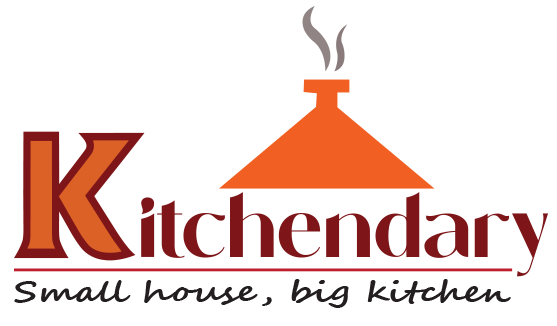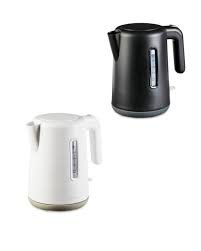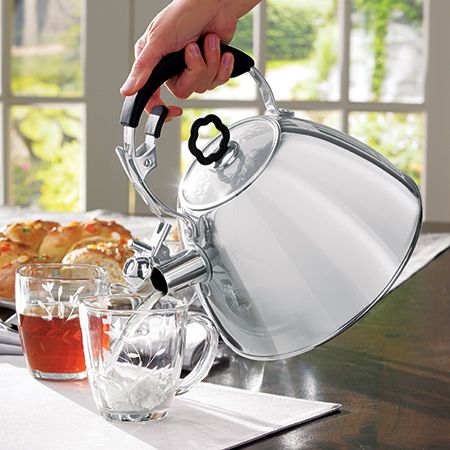A pourover kettle is a specialized kettle used for making pour-over coffee or tea. It allows for precise pouring control.
A pourover kettle is an essential tool for enthusiasts of pour-over coffee or tea. It offers precise pouring control and a gooseneck spout for accurate water flow, allowing for a consistent extraction of flavors. The design ensures an evenly saturated bed of coffee grounds or tea leaves, resulting in a flavorful and aromatic brew.
Whether you are a seasoned barista or a home brewing enthusiast, a pourover kettle can elevate your brewing experience. With its ergonomic handle and sleek design, it provides both functionality and aesthetics to your brewing ritual. If you are looking to master the art of pour-over brewing, investing in a pourover kettle is a wise choice.
Understanding The Pourover Coffee Process
Origins And Evolution Of Pourover Coffee
Pourover coffee has a rich history that dates back to the early 20th century, with its origins traced to Germany and later gaining popularity in Japan. The method has evolved significantly over the years, with various adaptations and improvements made to the equipment and brewing techniques. Today, pourover coffee has become a beloved staple for coffee enthusiasts around the world.
The Role Of Water Temperature In Brewing
The temperature of the water used in pourover coffee brewing plays a crucial role in extracting the flavors and aromas from the coffee grounds. The ideal water temperature for brewing is typically between 195°F to 205°F. This range helps to optimize the extraction process, ensuring that the flavors are fully developed without risking bitter or burnt-tasting coffee.
Importance Of The Pouring Technique In Extraction
The pouring technique employed during pourover brewing is essential for achieving a well-extracted and balanced cup of coffee. A controlled and steady pour, preferably in a circular motion, ensures that the water interacts evenly with the coffee grounds, promoting consistent extraction. This technique also allows for the release of carbon dioxide gas, resulting in a cleaner and more flavorful brew.
Choosing The Right Pourover Kettle
When it comes to perfecting your pour-over coffee brewing technique, choosing the right pour-over kettle is essential. A precision pour kettle not only enhances the aesthetics of your brewing setup but also plays a crucial role in achieving an even extraction from your coffee grounds. In this guide, we will delve into the key features to consider when selecting the ideal pour-over kettle and explore the impact of gooseneck design on control and accuracy. By the end of this article, you will be equipped with the knowledge to choose the perfect kettle that suits your brewing preferences.
Features To Consider In A Precision Pour Kettle
When selecting a precision pour kettle, several key features should be taken into consideration to ensure the best brewing experience. These features include:
- Capacity: Determine the ideal volume based on your typical brewing quantity.
- Material: Consider the heat conductivity and durability of materials such as stainless steel, copper, or glass.
- Handle design: Look for ergonomically designed handles for a comfortable grip during pouring.
- Temperature control: Some kettles offer integrated thermometers or temperature display for precise water temperature management.
Comparing Different Kettle Types And Materials
When comparing pour-over kettle types and materials, it’s important to evaluate the pros and cons of each. Stainless steel kettles are known for their durability and heat retention, while copper kettles are prized for their efficient heat conductivity. Glass kettles offer the advantage of visibility, allowing you to monitor the water level and heating process. Each material has its unique attributes, so consider your brewing preferences and requirements before making a decision.
The Impact Of Gooseneck Design On Control And Accuracy
The gooseneck design of a pour-over kettle is instrumental in achieving precision and control during the brewing process. The slender, curved spout allows for a steady, controlled pour, which is essential for evenly saturating the coffee grounds and controlling the flow rate. The design influences the overall brewing experience, impacting the extraction and flavor profile of the coffee. Therefore, the gooseneck design is a critical factor to consider when selecting a pour-over kettle.
By considering these key features and understanding the impact of gooseneck design, you can select the ideal pour-over kettle that complements your brewing preferences and elevates your pour-over coffee experience.
Mastering The Pouring Technique
Mastering the pouring technique is crucial in achieving the perfect cup of coffee with a pourover kettle. By understanding the intricacies of controlled pouring, pour rate, and adjusting technique based on variables such as coffee type and grind, you can elevate your coffee brewing to new heights. Let’s delve into the art of mastering the pouring technique to unlock the full potential of your pourover kettle.
Perfecting The Controlled, Circular Pour
Achieving a controlled, circular pour is essential for evenly saturating the coffee grounds and promoting balanced extraction. Through a consistent and steady pour, you can ensure that every part of the coffee bed receives an equal amount of water, leading to a more uniform extraction and enhanced flavor profile.
Understanding The Effect Of Pour Rate On Extraction
By grasping the impact of pour rate on extraction, you can adjust the flow of water to optimize the brewing process. A slower pour rate allows for increased contact time between water and coffee, yielding a more thorough extraction. Conversely, a faster pour rate can emphasize certain flavor characteristics. Experimenting with different pour rates enables you to tailor the extraction to your preferences.
Adjusting Pouring Technique Based On Coffee And Grind Type
Adapting your pouring technique to the specific coffee and grind type you are using can make a significant difference in the final cup. Finer grinds typically benefit from gentler pours to prevent channeling, while coarser grinds may require a slightly faster pour to ensure proper agitation. Understanding how different variables interact with pouring technique allows for fine-tuning your approach for optimal results.
Experimenting With Different Pouring Patterns For Optimal Results
Exploring various pouring patterns can unlock a spectrum of flavors and aromas in your coffee. Whether it’s a concentric spiral, gentle zigzag, or strategic pulse pouring, each pattern can influence how the water interacts with the grounds, ultimately impacting the extraction process. By experimenting with different pouring patterns, you can tailor the brewing method to bring out the best in every cup.
Enhancing Precision With Temperature Control
Pourover brewing enthusiasts understand the importance of precision when it comes to temperature control in the process. Achieving the perfect water temperature can make a significant difference in flavor extraction and overall consistency. In this section, we’ll delve into the significance of water temperature in pourover brewing, explore precision temperature control options in kettles, and understand the impact of consistent temperature on flavor extraction.
The Significance Of Water Temperature In Pourover Brewing
Water temperature plays a crucial role in the pourover brewing process. It directly affects the extraction of flavors from coffee grounds. Consistently achieving the ideal temperature can result in a well-balanced and flavorful cup of coffee.
Exploring Precision Temperature Control Options In Kettles
When it comes to enhancing precision in pourover brewing, having a kettle with temperature control options is essential. Modern pourover kettles offer various features such as preset temperature settings, real-time temperature display, and sophisticated heating mechanisms to ensure the water remains at the desired temperature throughout the brewing process.
The Impact Of Consistent Temperature On Flavor Extraction
Consistent water temperature throughout the brewing process leads to more uniform flavor extraction. This, in turn, results in a richer, more balanced, and aromatic cup of coffee. The ability of a temperature-controlled kettle to maintain a steady and accurate temperature significantly impacts the final flavor profile of the brewed coffee.
Achieving Brewing Consistency With Temperature-controlled Kettles
Temperature-controlled kettles play a pivotal role in ensuring brewing consistency. They provide coffee enthusiasts with the ability to reproduce and fine-tune their brewing process by maintaining precise water temperatures. This level of control leads to repeatable, high-quality brews, enhancing the overall pourover experience.
Maintaining And Caring For Your Pourover Kettle
When it comes to making the perfect cup of pour-over coffee, your kettle plays a crucial role in the process. Proper maintenance and care of your pourover kettle are essential to ensuring its longevity and continued performance. From cleaning and descaling to troubleshooting common issues, here are the best practices to maintain and care for your precision pour kettle.
Cleaning And Descaling Best Practices
Regular cleaning and descaling of your pourover kettle are vital for maintaining its functionality and preventing mineral buildup. Here are some best practices for cleaning and descaling your kettle:
- After each use, rinse the kettle with hot water and mild dish soap
- For removing mineral deposits, descale the kettle using a mixture of white vinegar and water
- Use a soft-bristled brush to scrub the interior of the kettle gently
- Rinse thoroughly with water after descaling to remove any lingering vinegar
- Dry the kettle thoroughly before storage to prevent corrosion
Proper Storage And Maintenance Of Your Kettle
Proper storage and maintenance practices can significantly extend the lifespan of your pourover kettle. Follow these tips to ensure your kettle stays in optimal condition:
- Store the kettle in a dry, well-ventilated area to prevent moisture buildup
- Keep the kettle lid open when not in use to allow air circulation and prevent odors
- Inspect the kettle for any signs of wear or damage and address issues promptly
- Periodically oil any wooden or bamboo handles to prevent cracking and maintain aesthetics
Troubleshooting Common Kettle Issues
Even with proper care, pourover kettles may encounter common issues. Here are some troubleshooting tips to address these problems:
- If the kettle leaks, check for any cracks or damage and replace any faulty parts
- If the kettle produces excessive steam or fails to reach the desired temperature, inspect the heating element and connections
- For uneven pouring, ensure the kettle spout is free from any obstructions and water flow is consistent
- Address any electrical issues by checking the power cord and ensuring it is securely connected
Extending The Lifespan Of Your Precision Pour Kettle
By implementing these maintenance and care practices, you can extend the lifespan of your precision pour kettle, ensuring that it continues to deliver the perfect pour-over coffee experience for years to come.

Credit: www.amazon.com
Frequently Asked Questions Of Pourover Kettle
What Is A Pourover Kettle?
A pourover kettle is a specialized kettle with a slender spout designed for precise control over the water flow, making it ideal for brewing pour-over coffee or tea. Its ergonomic design ensures an even and controlled extraction, resulting in a flavorful cup.
Why Use A Pourover Kettle?
Using a pourover kettle allows for a controlled, steady stream of water, which enhances the brewing process by evenly saturating the coffee grounds or tea leaves. This ensures a more consistent extraction, resulting in a delicious, full-flavored beverage with optimal clarity and aromatic nuances.
How To Choose The Right Pourover Kettle?
When selecting a pourover kettle, consider factors such as capacity, material (stainless steel or copper), handle design for comfortable grip, and a gooseneck spout for precise pouring. Opt for a kettle that aligns with your brewing preferences and complements your brewing setup for an enjoyable experience.
What Are The Benefits Of Using A Pourover Kettle?
The main advantage of using a pourover kettle is the precise control it offers over the water flow, resulting in a balanced and flavorful cup of coffee or tea. Additionally, it allows for a more interactive brewing process, enabling enthusiasts to refine their technique and elevate their brewing skills.
Conclusion
A pour-over kettle is an essential tool for anyone who enjoys brewing their coffee. With its precise control and ergonomic design, it enhances the pour-over coffee making experience. The right kettle can make a noticeable difference in the flavor of your coffee.
Invest in a pour-over kettle for a better coffee brewing experience.




